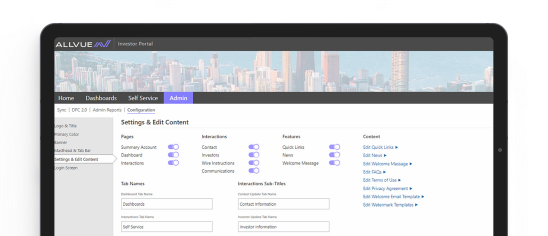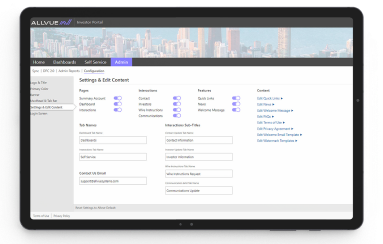
By: Michelle Wu
Head of Marketing
October 7, 2025
Like it or not, gone are the days of legacy processes like good old-fashioned spreadsheets and email chains. They served their purpose, but simply put, they just can’t keep up with today’s expectations for speed, accuracy, and transparency. That’s why private equity as a whole has begun its digital transformation, with firms rapidly shifting towards comprehensive future-facing solutions.
Modern private equity firms are turning to purpose-built technology to deliver better results for investors and improve internal operations. From automating fund accounting to enabling faster decision-making, these tools are streamlining workflows, providing real-time data, and enabling smarter decisions. The result? A new reality in efficiency and performance in private markets.
Let’s take a look at leading private equity tools for finance industry firms and how they’re powering modern PE.
The Evolving Role of Tech in Private Equity
The influx of tech-based solutions isn’t unique to a single industry, and the reason it’s taking over many industries is simple — it makes firms and businesses work better.
The Push for Transparency and Operational Efficiency
Limited partners (LPs) and regulators alike are demanding more frequent, detailed, and transparent reporting. This shift puts immense pressure on finance, investor relations, and operations teams to deliver clean, accurate data faster than ever.
Fortunately, that’s where technology steps in. Instead of relying on siloed systems or inconsistent manual processes, modern tools help firms scale their operations, provide up-to-date data analytics, and stay ahead of compliance expectations. With key features like built-in audit trails, data validations, and secure access protocols, modern transparency demands are moving from a burden to an easy-to-meet standard.
Replacing Spreadsheets with Purpose-Built Platforms
If you’re not on the forefront of technology adoption, or you’ve just been around long enough, you’ll know the bane that is spending hours inputting data into spreadsheets — not to mention the other hassles like manual errors and maintaining version control.
While you’re probably not going to be free of spreadsheets altogether, purpose-built platforms aim to tidy up the whole process. By implementing centralized, cloud-based tools, teams work from a single source of truth with up-to-date data for enhanced speed, visibility, and collaboration, plus a better way to collect and analyze KPIs and key financials.

Essential Private Equity Tools for Modern Finance Teams
To keep up with the evolving expectations in private equity, certain tools have become non-negotiable. These are the pillars of a well-integrated tech stack, with each one playing a critical role in simplifying workflows, improving accuracy, and scaling operations.
Let’s take a look at the “must-haves” when searching for modern private equity tools.
Fund and Corporate Accounting Software
Modern fund and corporate accounting software should go beyond managing the basics of fund structures, financial reporting, and bookkeeping. For private equity firms, the stakes are higher and the workflows are increasingly more complex. Today’s finance teams need tools that can handle the intricate layers of fund families, co-investments, SPVs, and bespoke waterfall arrangements without slowing down.
Key functions to look for in accounting software:
- Automated general ledgers featuring a large library of financial reports and flexible, customizable output
- The ability to handle complex waterfall and allocation calculations
- Accelerated close cycles
- Built-in compliance and audit trail tracking
- Support for funds, SPVs, co-investments, and more
Investor Portals with Real-Time Access
Maintaining top-tier investor communications while experiencing growth can demand a lot of resources. Or at least it used to. With investor portal software solutions, GPs can automate large chunks of the process, such as key investor notice generation and distribution, investor dashboard branding, and easy-to-follow tracking of investment activity and portfolio performance.
Some other benefits investor portals provide include:
- Real-time, 24/7 access to statements, reports, and capital calls
- Reduced back-and-forth email volume with investor relations
- Consistent messaging across investors
- Secure, on-demand access to documents and performance data
- Enhanced transparency for better investor trust and satisfaction
Portfolio Monitoring and Reporting Tools
Closely monitoring detailed and up-to-date data is one of the keys to leveling up performance, be that in sports, finance, or really any industry. For PE fund managers, collecting, analyzing, and reporting on performance and operating metrics is the basis for finding areas to improve and grow.
A proper portfolio monitoring tool provides a number of benefits and features, such as:
- Streamlined data collection and fund performance reporting
- Real-time access to data, helping track KPIs across portfolio companies
- Generated dashboards and reports for internal teams and LPs
- Shareable data for internal stakeholders, operating partners, and LPs
- Strategic insights to help make informed, proactive management decisions
What to Look for in a Scalable Private Equity Platform
Some technology might be better than no technology, but not all private equity software is created equal. If you want a platform that can meet your needs now, but also scale into the future, here’s what to look for.
Seamless Integrations Across the Tech Stack
For PE firms of any size, siloed systems are a recipe for disaster. If systems aren’t integrated with one another, even the most powerful tools can fall into the common pitfalls of fragmented systems. Avoid solutions that require constant exports, manual uploads, or duplicate data entry. Instead, look for a platform that creates a single source of truth and can seamlessly integrate with existing tools like Excel, Outlook, ERP, and third-party data providers.
Vendor Support, Security, and Compliance Readiness
Even if you find a PE software system that offers the world in features, it would be useless if it didn’t come with enterprise-grade protections like SOC1 and SOC2 compliance, role-based access controls, encryption at rest and in transit, and robust backup protocols. With PE firms increasingly operating across borders, global regulatory compliance standards also matter, meaning things like GDPR and SEC requirements must also be baked in.
Beyond security non-negotiables, ongoing vendor support is just as important. Onboarding vendors, providing updates, and creating easy-to-follow audit trails are yet another requirement for meeting vendor needs and maintaining sufficient security and compliance readiness standards.
Built-in Flexibility to Grow with the Firm
One of the worst things you can do when adopting new technology is pick something that meets your needs now, but might not in the future. Any platform you choose should support future growth, such as new fund launches, asset classes, and regions. Modular architecture is also a plus, allowing you to change or build up new configurations at your own pace, without the need to replatform.
Driving Better Decisions with Unified Data
It’s already been mentioned briefly, but the importance of efficiently collecting data for decision-driving insight is worth reiterating. By centralizing and unifying data, you gain the power of confident and informed decisions.
Centralizing Fund, Investor, and Market Intelligence
When fund performance data, investor records, and market insights live in separate systems, the result is fragmentation and blind spots. CFOs, deal teams, and investor relations professionals often end up working from different versions of the truth.
A unified platform, however, removes those barriers. It ensures teams are all working from the same information, empowering them to make better decisions based on shared intelligence that offers a fuller, clearer picture of risk, opportunity, and exposure.
Automating Reporting for Faster Close Cycles
Tools that automate recurring reports like financial statements — including balance sheets, income statements, schedules of investments, and statements of cash flows — can help ease the strain of and speed up close cycles. The same tools can also automatically produce investor-level reports with drill-through reporting, helping with both reconciliation and answering any urgent investor requests. Together, the result is faster reporting that improves responsiveness and resource efficiency.
When these reporting tools are connected to a centralized data environment, the benefits compound. Unified data ensures that reports draw from a single, consistent source, eliminating discrepancies between systems and enabling CFOs and finance teams to move confidently through audits, LP requests, and internal reviews.
Improving Collaboration Across Functions
If creating a centralized location for unified data is step one, then enabling and improving collaboration is the next logical step. Here’s how shared tools are helping teams work faster and communicate better:
- Empowering Finance, IR, and Ops Teams with Shared Tools: Finance teams no longer need to work off different versions of a spreadsheet or email attachments. By using shared tools and working off common data models, firms are able to reap the benefits of a shared source of truth, including fewer delays, fewer errors, increased accountability, and streamlined workflows.
- Aligning Fund Performance and Investor Communication: When fund performance data and investor updates live in the same system, messaging stays consistent across teams. IR no longer has to chase numbers or reconcile reports from multiple sources, allowing them to respond faster and more accurately to LP inquiries.
Improve Collaboration and Workflows with Allvue
The right tech stack transforms how private equity firms operate, making data smarter, workflows smoother, and collaboration stronger. Integrated systems reduce friction, align teams, and enable faster, more informed decisions.
Now is the time to take stock. Audit your current tools and identify gaps in integration, scalability, or reporting. If your platform isn’t evolving with your firm, it may be holding you back.
Find out how Allvue’s unified solution is powering the future of private equity and helping firms adopt systems that are efficient, connected, and ready to scale.
More About The Author

Michelle Wu
Head of Marketing
Michelle is a dynamic marketing leader with 15+ years of experience in capital markets, fintech, and cybersecurity technology industries. Prior to joining Allvue, Michelle was the Vice President of Product Marketing at SecurityScorecard, a global leader in cybersecurity ratings, and was the Head of Security & Compliance Marketing at Box. Before moving into cybersecurity, she led the Banking & Securities GTM strategy at Intralinks and covered capital markets clients at HSBC. She holds an MSc in Media & Communications from the London School of Economics and a BS in Marketing & Finance from NYU Stern School of Business.



